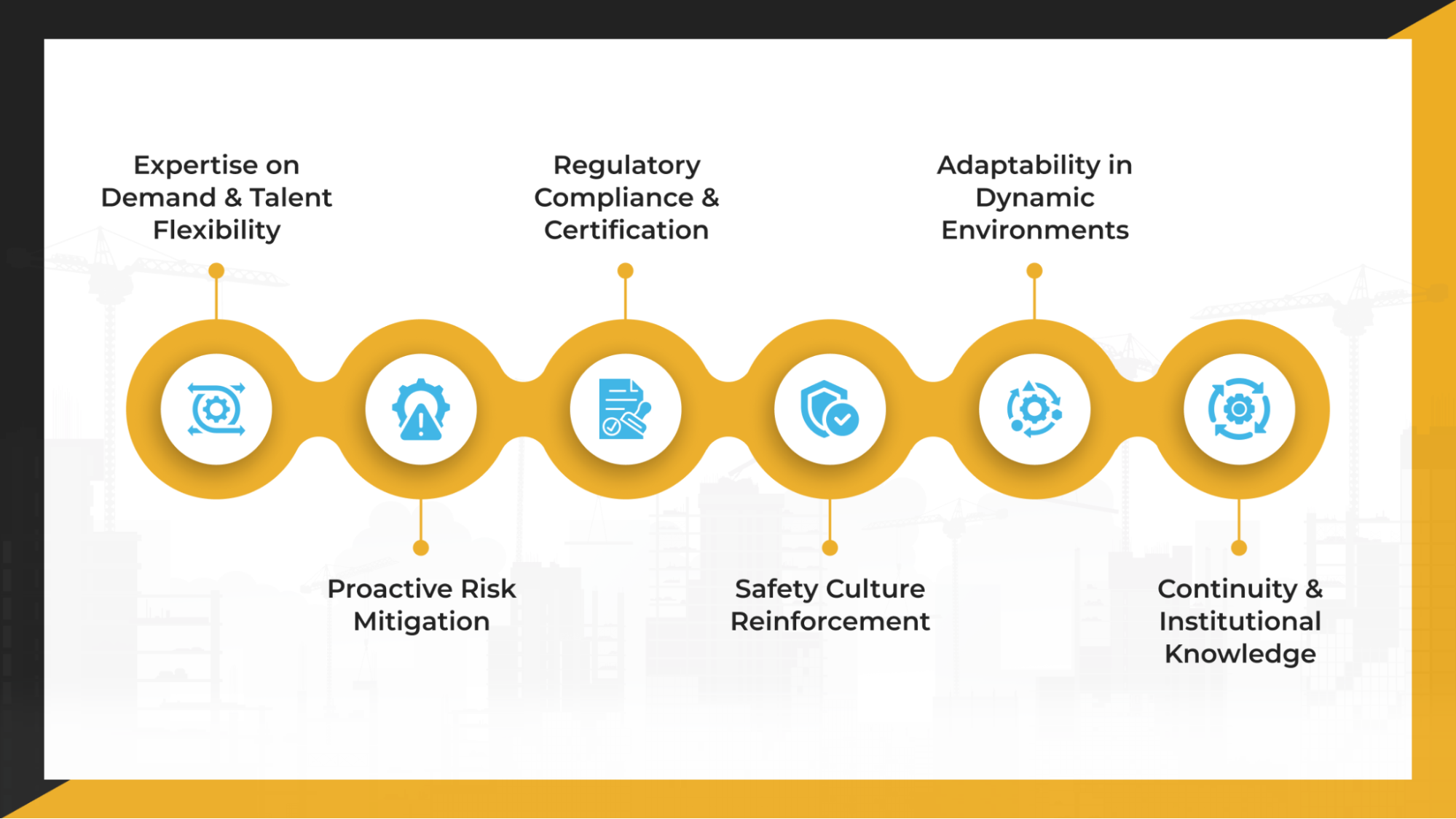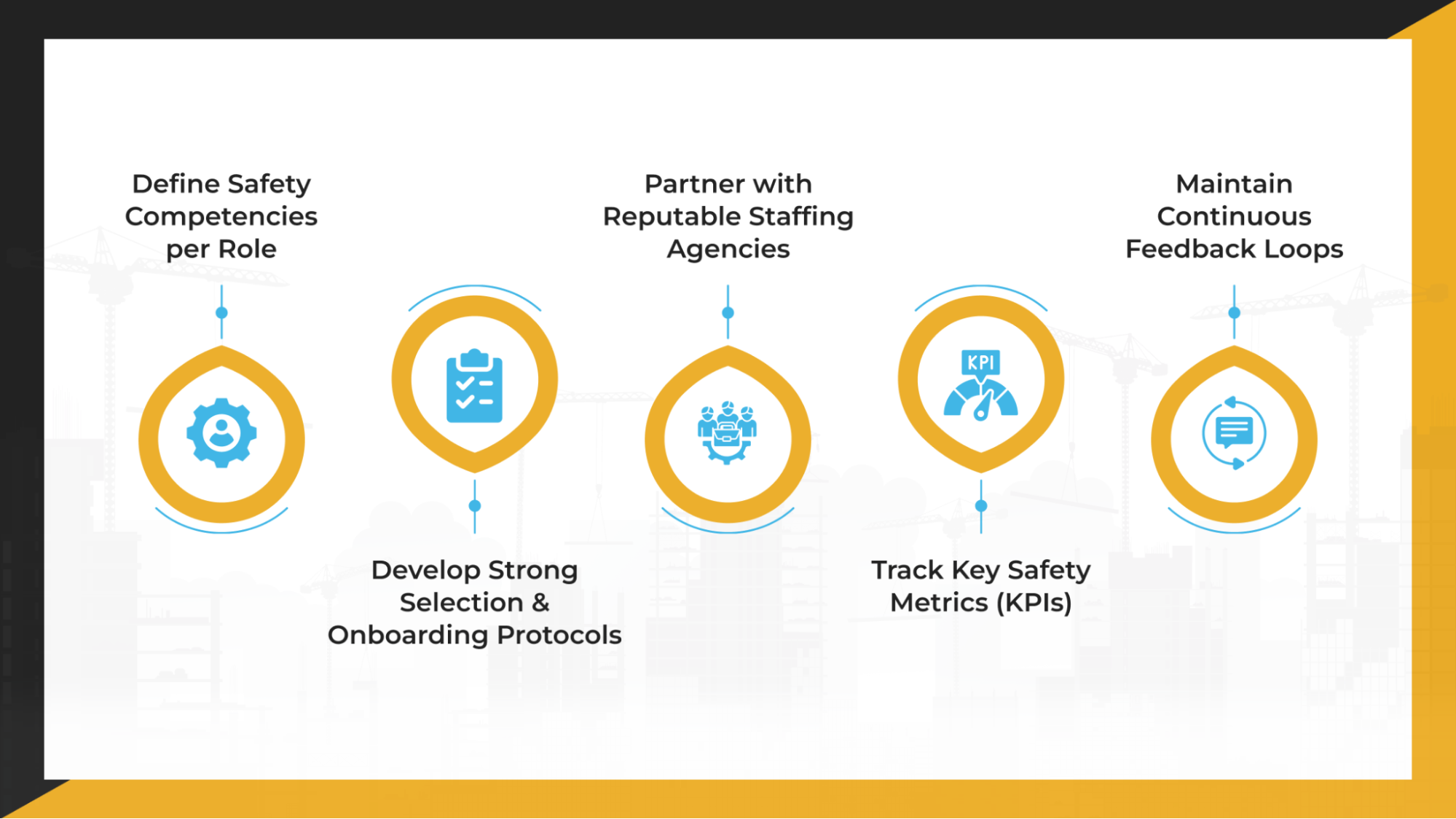Workplace injuries cost businesses billions each year. In 2023, U.S. companies lost over $176.5 billion due to work-related incidents, from medical expenses and legal claims to productivity loss and operational downtime.
In industries like construction, manufacturing, oil & gas, logistics, and energy, where risk is part of the job every day, keeping worksites safe, compliant, and efficient is more important than ever.
But with growing project demands, changing regulations, and a shortage of skilled workers, many companies are finding it tough to stay on top of things. That’s where strategic safety staffing can make a difference.
By hiring qualified safety professionals, either full-time or as needed, businesses can tackle immediate risks, stay compliant, and create a strong safety culture that supports long-term success. It focuses on bringing in expertise, foresight, and flexibility that become a core part of everyday operations in high-risk industries.
In this blog, we’ll explore the advantages of safety staffing, the factors driving its growth, and how you can put a framework in place that protects both your workforce and your profits.
What Is Safety Staffing and Why Does It Matter in High-Risk Industries?
Safety staffing refers to the strategic placement of trained safety professionals, such as safety officers, Environmental Health & Safety (EHS) leads, or site safety supervisors, at workplaces where the risk of accidents or injuries is high.
These professionals may be hired on a temporary, project-based, or permanent basis, depending on the needs of the job site or industry. Here is why it is essential to hire a safety professional for high-risk industries:
1. Cost Avoidance & Financial Impact
Workplace injuries come with a heavy price. In the United States, workplace injuries cost employers approximately $58.8 billion annually, according to Liberty Mutual’s 2025 Workplace Safety Index. Beyond the financial impact, the human cost remains significant.
In the U.S., a worker dies on the job roughly every 99 minutes, highlighting the ongoing need for adequate safety measures. By hiring qualified safety professionals, companies can reduce incidents and avoid these massive costs.
2. Operational Continuity & Efficiency
Accidents disrupt operations. Injuries often lead to project delays, shutdowns, and reassignments, creating workflow gaps. When trained safety staff are on-site, they help spot risks early, enforce safety protocols, and ensure smooth day-to-day functioning.
3. Lower Insurance Premiums & Risk Exposure
Insurance providers assess workplace safety records when setting premiums. Fewer incidents mean lower risk, and that often translates to reduced insurance costs. A solid safety staffing model shows insurers that the company takes risk management seriously, making the organization a better candidate for favorable coverage rates.
4. Enhanced Brand Reputation & Stakeholder Trust
Clients, investors, and business partners want to work with companies that value safety. A proven safety record boosts credibility and positions a business as responsible and reliable. Showcasing a strong safety culture also supports long-term relationships with regulatory bodies and customers who prioritize ESG (Environmental, Social, Governance) compliance.
5. Employee Morale, Retention & Talent Attraction
Workers feel safer and more supported in environments where safety is prioritized. This leads to higher morale, stronger team engagement, and better employee retention. Skilled professionals, especially those in high-risk roles, are more likely to join and stay with companies that demonstrate a clear commitment to worker safety.
Essential Benefits of Safety Staffing for High-Risk Industries
Hiring trained safety professionals provides more than just regulatory compliance. Here’s a breakdown of the significant advantages that help companies in high-risk industries work smarter, safer, and more efficiently.
1. Expertise on Demand & Talent Flexibility
Outsourcing safety roles gives companies quick access to trained professionals without going through long hiring processes. Whether there’s a sudden increase in workload, a safety audit coming up, or a full-time staff member on leave, staffing partners can send qualified experts when needed.
This flexibility ensures that safety isn’t compromised during critical project phases. At Safe T Professionals, we provide highly skilled safety professionals for projects of any size, catering to both long-term and short-term needs.
2. Proactive Risk Mitigation
Dedicated safety staff help prevent problems before they occur. They run hazard assessments, lead toolbox talks, and organize safety drills to make sure workers understand potential dangers.
This reduces the likelihood of injuries and keeps projects on track. This is especially useful in industries like oil & gas, where minor errors can lead to significant incidents.
3. Regulatory Compliance & Certification
Safety professionals are often certified with credentials like OSHA 30, CSP (Certified Safety Professional), or CHST (Construction Health and Safety Technician). These certifications ensure that they’re familiar with current safety laws and standards. Staffing agencies also verify these qualifications before assigning someone to a site. This reduces the risk of hiring unqualified or undertrained personnel.
At Safe T Professionals, we have a team of experts who are thoroughly trained in EHS (Environmental, Health, and Safety) and possess comprehensive knowledge of OSHA standards, as well as state and local regulations, ensuring your team remains compliant and safe.
4. Safety Culture Reinforcement
When safety staff work directly on-site with teams, they become part of the day-to-day operations. They collaborate with supervisors, support crews, and actively take part in meetings and planning. This helps strengthen a safety-first culture and makes safety practices a regular part of how the job gets done, not just a checklist.
5. Adaptability in Dynamic Environments
High-risk industries often face changing conditions, weather, machinery issues, site layout changes, or evolving project scopes. Experienced safety professionals can quickly adjust safety plans to match these changes, ensuring workers remain protected even in unpredictable situations.
6. Continuity & Institutional Knowledge
When companies use the same staffing partners or professionals across multiple projects, there’s a substantial benefit in continuity. The safety staff become familiar with the company’s processes, expectations, and past challenges. This knowledge helps maintain safety momentum and avoids starting from scratch with each new project.
The New Trends Shaping Safety Staffing in High-Risk Industries
The way companies approach safety staffing is evolving, driven by workforce challenges, changing business needs, and the adoption of data technologies. These trends are reshaping how safety roles are filled and managed across high-risk industries.
1. Talent Scarcity & Rising Expectations
Many industries are facing a shortage of qualified safety professionals. High attrition rates, fewer new entrants into the safety field, and changing work preferences are all contributing to this gap.
In addition, expectations from employers are increasing; safety professionals are now expected to bring not only technical expertise but also leadership, adaptability, and communication skills. This mismatch between demand and supply makes it harder for companies to hire and retain experienced safety talent internally.
2. The Ascent of EHS Staffing Partners
To address the talent gap, organizations are turning to EHS (Environmental Health & Safety) staffing partners. These partners, such as SafeTProfessionals, go beyond recruitment; they act as full-service providers that:
- Supply pre-vetted and certified safety professionals.
- Offer flexible staffing solutions for short-term, long-term, or emergency needs.
- Build scalable safety talent networks that companies can tap into based on project demands.
This allows businesses to maintain high safety standards without being limited by internal hiring constraints.
3. Data-Driven & Predictive Safety Integration
Companies are increasingly using data to guide safety decisions. Instead of reacting to incidents, leading firms track leading indicators like near-misses, unsafe behaviors, and environmental data to predict potential issues.
Predictive analytics tools help safety teams identify patterns and intervene early, before accidents happen. When paired with strategic staffing, this proactive model ensures that safety professionals are not just enforcing rules but also guiding continuous improvement based on real-time data.
How to Implement a Successful Safety Staffing Strategy?
A structured approach to safety staffing ensures that the right people are hired, integrated effectively, and continuously supported to perform at their best. Below is a detailed framework that companies can use to build a reliable and efficient safety staffing system:
1. Define Safety Competencies per Role
Start by identifying what each safety role requires. This includes:
- Certifications: OSHA 30, CSP, CHST, or industry-specific credentials.
- Technical Skills: Knowledge of hazard control methods, incident reporting, site audits, etc.
- Behavioral Traits: Communication skills, leadership, decision-making, and risk awareness.
Clearly outlining these requirements helps avoid hiring mismatches and ensures all safety staff meet operational needs.
2. Develop Strong Selection & Onboarding Protocols
To hire the right candidates, companies should use tools like:
- Behavioral assessments: To understand how candidates respond to pressure or routine challenges.
- Safety culture alignment: Evaluate if their values and habits align with your company’s safety expectations.
- Situational judgment testing: Assess how they would handle real-world safety scenarios.
Once selected, onboarding should introduce them not just to processes, but also to site-specific risks and safety protocols. This structured evaluation ensures that safety staff can both fit in and perform effectively from day one.
3. Partner with Reputable Staffing Agencies
Work with staffing providers who specialize in EHS roles. Make sure they verify certifications and experience. Assess soft skills and technical fit. Understand your industry’s specific needs.
Reliable partners reduce the risk of underqualified placements and save time in recruitment.
At SafeTProfessionals, we are committed to providing exceptional safety training, consulting, and staffing solutions. This can help you reduce the risk of underqualified placements and save time in recruitment, ensuring you get the best safety talent for your needs.
4. Track Key Safety Metrics (KPIs)
Use data to evaluate the effectiveness of your safety staffing strategy. Key metrics to monitor include:
| Key Performance Indicators | Description |
| Incident Rates and Injury Frequency | Measures the number and frequency of workplace injuries. |
| Near-Miss Reports: | Tracks potential incidents that could have caused harm but didn’t. |
| Audit Performance: | Assess the results of safety audits for compliance and improvement. |
| Employee Feedback and Safety Culture Surveys | Gathers employee input on safety practices and culture. |
Reviewing these numbers regularly helps identify weak spots and improve future hiring or training decisions.
5. Maintain Continuous Feedback Loops
Create systems that encourage two-way communication between safety staff and leadership. Regular check-ins, performance reviews, and feedback sessions help address issues early, update training needs, and keep teams aligned on safety goals. This process ensures your workforce stays prepared and engaged and improves overall safety outcomes.
Enhance Workplace Safety with SafeTProfessionals Staffing Solutions
At Safe T Professionals, we are dedicated to elevating safety standards through our expert consulting and staffing services. By proactively addressing and preventing safety issues and equipping your workforce with the necessary knowledge and tools, we help create a safer work environment.
Partner with Safe T Professionals to enhance your company’s safety protocols and ensure compliance with industry standards. Whether you are looking to fill safety-specific roles or need expert consultation to mitigate workplace hazards, we are here to help.
Connect with us today!




